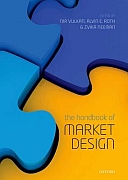| |||||
• polskie
• Zamów informacje o nowościach z wybranego tematu • kontakt |
THE HANDBOOK OF MARKET DESIGNROTH A.E. VULKAN N. NEEMAN Z.wydawnictwo: OXFORD UNIVERSITY, 2013, wydanie Icena netto: The Handbook of Market DesignEconomists often look at markets as given, and try to make predictions about who will do what and what will happen in these markets Market design, by contrast, does not take markets as given; instead, it combines insights from economic and game theory together with common sense and lessons learned from empirical work and experimental analysis to aid in the design and implementation of actual markets In recent years the field has grown dramatically, partially because of the successful wave of spectrum auctions in the US and in Europe, which have been designed by a number of prominent economists, and partially because of the increase use of the Internet as the platform over which markets are designed and run There is now a large number of applications and a growing theoretical literature. The Handbook of Market Design brings together the latest research from leading experts to provide a comprehensive description of applied market design over the last two decades In particular, it surveys matching markets: environments where there is a need to match large two-sided populations to one another, such as medical residents and hospitals, law clerks and judges, or patients and kidney donors It also examines a number of applications related to electronic markets, e-commerce, and the effect of the Internet on competition between exchanges Introduction ; PART I: GENERAL PRINCIPLES ; 1. What Have We Learned From Market Design? ; 2. Not Up To Standard: Stress Testing Market Designs for Misbehavior ; 3. Using and Abusing Auction Theory ; PART II: CASES ; SECTION II.A: MATCHING MARKETS ; 4. Market Design for Kidney Exchange ; 5. School Choice ; 6. Improving Efficiency in School Choice ; 7. Can the Job Market for Economists be Improved? ; 8. Designing Markets for Ideas ; 9. Redesigning Microcredit ; 10. The Design of Online Advertising Markets ; SECTION II.B: AUCTIONS ; 11. The Product-Mix Auction: a New Auction Design for Differentiated Goods ; 12. Optimal Incentives in Core-Selecting Auctions ; 13. Auctioning Rough Diamonds: A Competitive Sales Process for BHP Billiton's Ekati Diamonds ; SECTION II.C: E COMMERCE ; 14. Ending Rules in Internet Auctions: Design and Behavior ; 15. Designing Markets for Mixed Use of Humans and Automated Agents ; 16. Very-Large-Scale Generalized Combinatorial Multi-Attribute Auctions: Lessons from Conducting $60 Billion of Sourcing ; 17. Designing Automated Markets for Communication Bandwith ; SECTION II.D: LAW DESIGN ; 18. A Mechanism Design Approach to Legal Problems ; 19. Legislation with Endogenous Preferences ; PART III: EXPERIMENTS ; 20. Common-Value Auctions with Liquidity Needs: An Experimental Test of a Troubled Assets Reverse Auction ; 21. Information Disclosure in Auctions: An Experiment ; 22. Buyer Determined Procurement Auctions Experiments ; 23. The Inefficiency of Splitting the Bill ; PART IV: COMPETING DESIGNS ; 24. Competing Mechanisms ; 25. Three Case Studies of Competing Designs in Financial Markets 720 pages, Hardcover Księgarnia nie działa. Nie odpowiadamy na pytania i nie realizujemy zamówien. Do odwolania !. |


